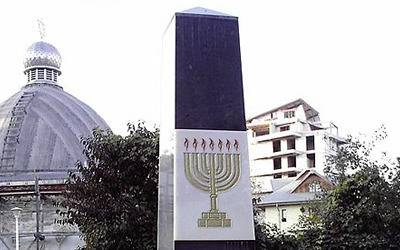The Ia?i pogrom or Jassy pogrom of 29 June 1941 was a series of pogroms launched by governmental forces under Ion Antonescu in the Romanian city of Ia?i (Jassy) against its Jewish population, resulting in the murder of at least 13,266 Jews.
According to a report commissioned by, and accepted by the Romanian government, the participation in the pogrom that followed was widespread:
Those participating in the manhunt launched on the night of June 28/29 were, first and foremost, the Iasi police, backed by the Bessarabia police and gendarmerie units. Other participants were army soldiers, young people armed by SSI agents, and mobs who robbed and killed, knowing they would not have to account for their actions....In addition to informing on Jews, directing soldiers to Jewish homes and refuges, and even breaking into homes themselves, some Romanian residents of Ia?i also took part in the arrests and humiliation forced upon the convoys of Jews on their way to the Chestura. The perpetrators included neighbors of Jews, known and lesser-known supporters of antisemitic movements, students, poorly-paid, low-level officials, railway workers, craftsmen frustrated by Jewish competition, "white-collar" workers, retirees and military veterans.
Soon Romanian soldiers, police, and mobs started massacring Jews; at least 8,000 were killed in the initial pogrom. SSI agents played a major role in leading the pogrom, often accompanied by soldiers and policemen. The newly freed Iron Guards indulged in their blood-thirsty brand of anti-semitism, leading mobs that stabbed or beat to death with crow-bars Jews on the streets of Ia?i. On rare occasions when the Legionaires felt merciful, they merely shot the Jews. One eyewitness later testified:
Sometimes, those who attempted to defend the Jews were killed with them. This was the case with engineer Naum, a gentile, brother-in-law of Chief Public Prosecutor Casian. Naum, a former Assistant Professor of Medical Chemistry at the Ia?i Institute of Hygiene, well-known in select circles as an eloquent defender of liberal views, attempted to save a Jew on Pacurari Street, outside the Ferdinand Foundation. The Romanian officer who was about to kill the Jew said to Naum, 'You dog, die with the kike you are defending!', and shot him point-blank. The priest Razmerita was shot on Sararie Street while attempting to save several Jews, dying with the victims he was trying to protect. While trying to defend some Jews on Zugravilor Street, outside Rampa, the lathe operator Ioan Gheorghiu was killed by railroad workers.
The Italian journalist Curzio Malaparte who witnessed the pogrom first-hand wrote about how "detachments of soldiers and gendarmes, groups of working men and women, groups of long-haired Gypsies squabbled, shouting with joy, as they undressed the corpses, lifted them and turned them over."
The Romanian authorities also arrested more than 5,000 Jews, forcing them to the train station, shooting those who did not move quickly enough, and then robbing them of all of their possessions. Over 100 people were stuffed into each car. Many Jews died of thirst, starvation, and suffocation aboard two trains that for eight days travelled back and forth across the countryside. According to the official report:
In the death train that left Ia?i for C?l?ra?i, southern Romania, which carried perhaps as many as 5,000 Jews, only 1,011 reached their destination alive after seven days. (The Romanian police counted 1,258 bodies, yet hundreds of dead were thrown out of the train on the way at Mirce?ti, Roman, S?b?oani, and Inote?ti.) The death train to Podu Iloaiei (15 kilometers from Ia?i) had up to 2,700 Jews upon departure, of which only 700 disembarked alive. In the official account, Romanian authorities reported that 1,900 Jews boarded the train and "only" 1,194 died.
Others were deported by train to Podu Iloaei, southwest of Ia?i. The total number of victims of the Ia?i pogrom is unknown, but the figure is calculated to be over 13,266 identified victims by the Romanian government, and nearly 15,000 by the Jewish community of Ia?i.
Unlike the Nazi German evacuations and exterminations, which involved black-ops, secrecy and deceit, this pogrom was perpetrated in "broad daylight" by Romanian authorities and the Romanian Army on Romanian citizens of Jewish origin in Romania proper.
In contrast to the Vel' d'Hiv Roundup in the zone occupée of France, where those arrested were transported to extermination camps in Nazi-occupied Poland, those arrested in the Ia?i pogrom were not transported outside of the country.
Photo from https://en.wikipedia.org/wiki/File:Ia%C8%99i_Pogrom_Monument_1.jpg by Rgvis





No Comments found